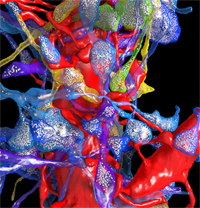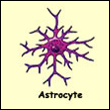Monday, 8 August 2016
A Nanometric 3D Representation of a Mouse Cortex Cortex
 The analogy between a real forest and a “forest of neurons” has been drawn many times, but the images produced most recently by the team of Jeff Lichtman and Narayanan Kasthuri (see the first two links below) make it clear yet again that the complexity of the brain’s connections far surpasses that of the densest forest.
The analogy between a real forest and a “forest of neurons” has been drawn many times, but the images produced most recently by the team of Jeff Lichtman and Narayanan Kasthuri (see the first two links below) make it clear yet again that the complexity of the brain’s connections far surpasses that of the densest forest.
As Lichtman has long said, by going down to the scale of the electron microscope and then reconstructing the slightest contacts between axons, dendrites, and neighbouring glial cells slice by slice, we can detect patterns that escape us at the more “macro” scales previously used to model neuronal connectivity. (more…)
From the Simple to the Complex | No comments
Monday, 16 April 2012
Fewer Glial Cells Than You Might Think?
 Most neuroscience textbooks still state that the number of glial cells (non-neuronal cells, such as astrocytes) in the human brain is far higher than the number of neurons. The figure often given is 10 times higher, and some authors even speak of up to 50 times higher. But studies done over the past few years offer a far more conservative estimate: a ratio of around one to one. (more…)
Most neuroscience textbooks still state that the number of glial cells (non-neuronal cells, such as astrocytes) in the human brain is far higher than the number of neurons. The figure often given is 10 times higher, and some authors even speak of up to 50 times higher. But studies done over the past few years offer a far more conservative estimate: a ratio of around one to one. (more…)
From the Simple to the Complex | 1 comment







